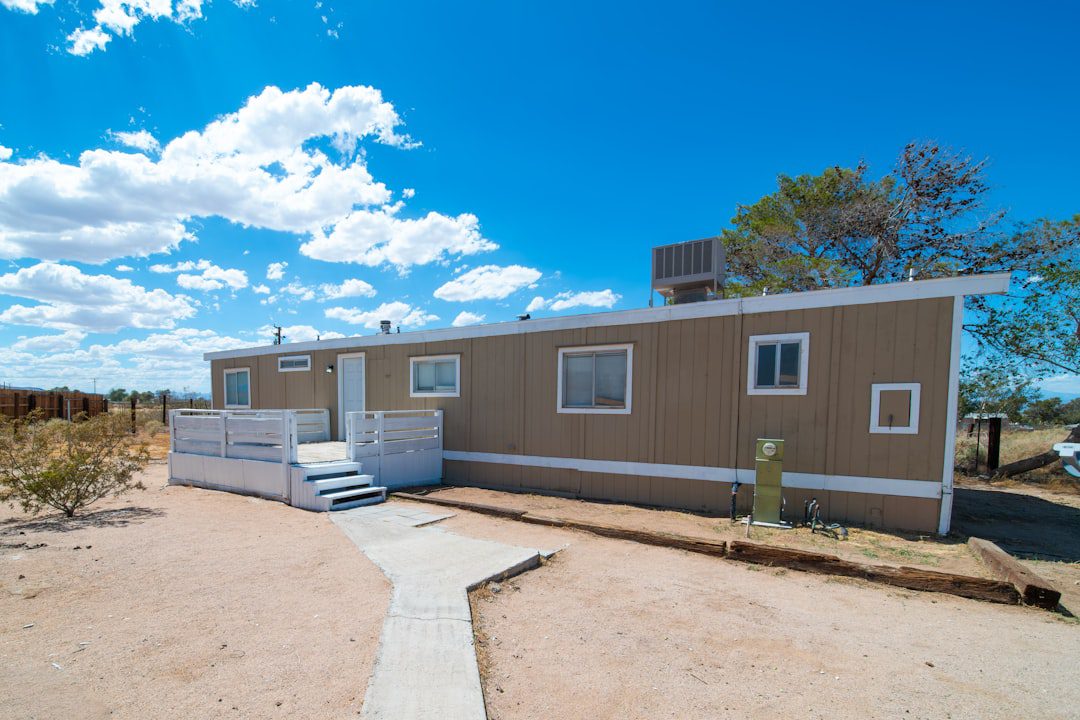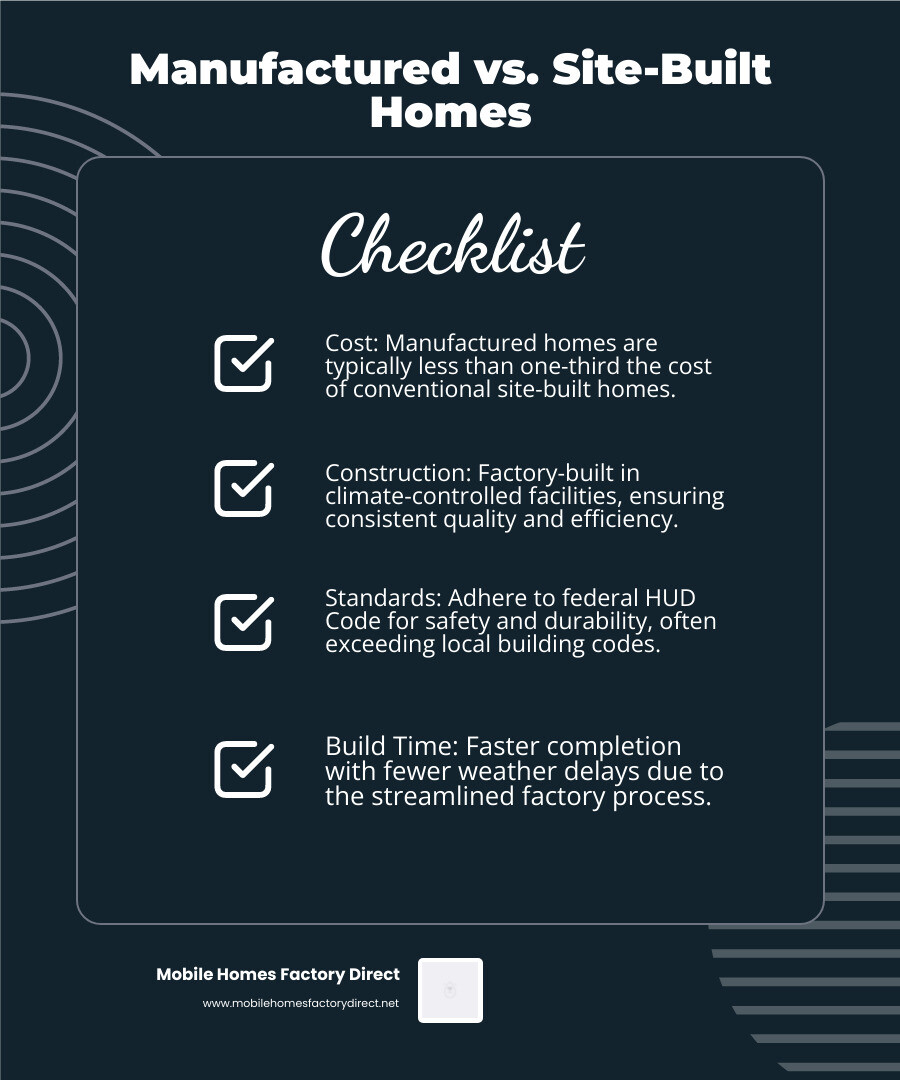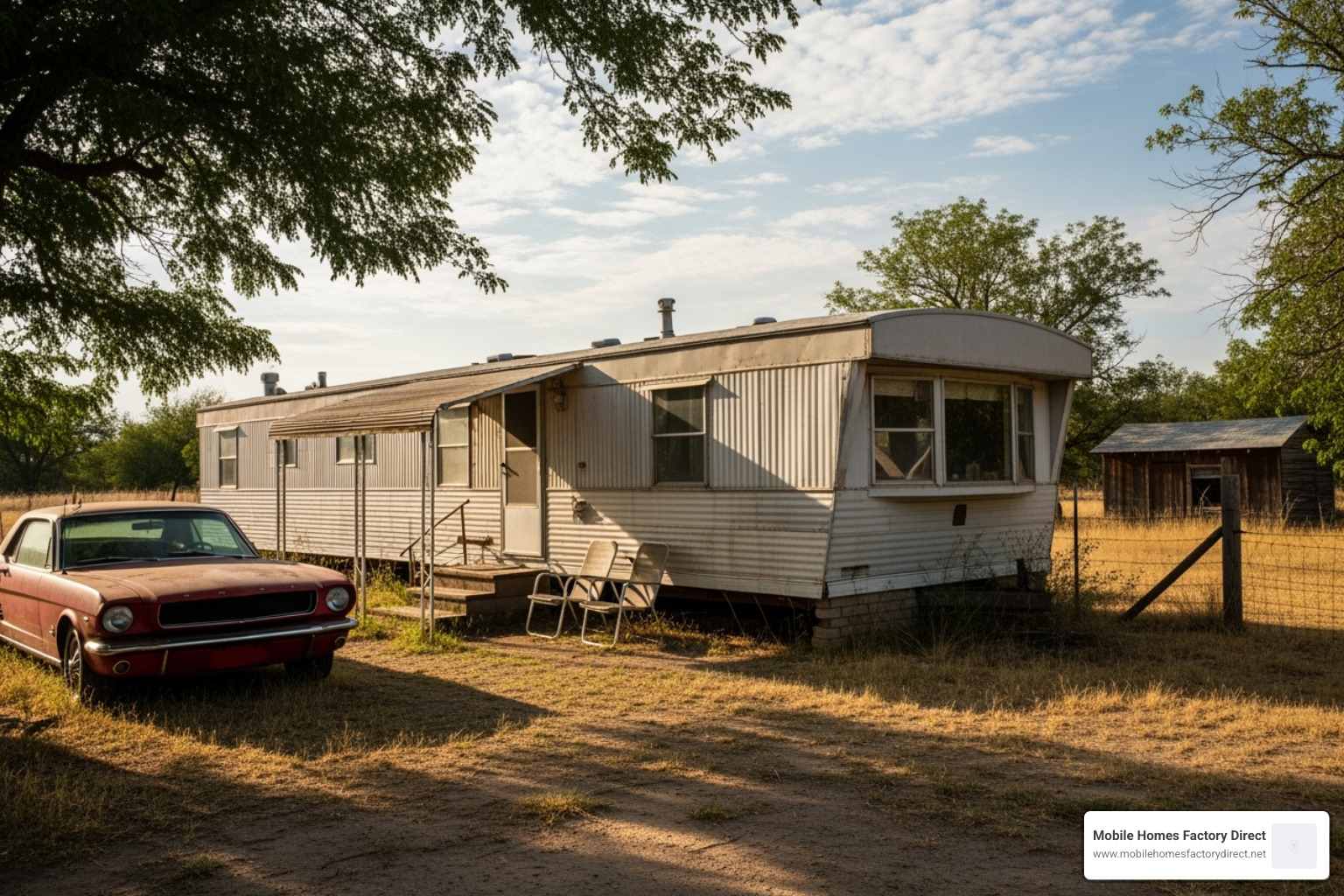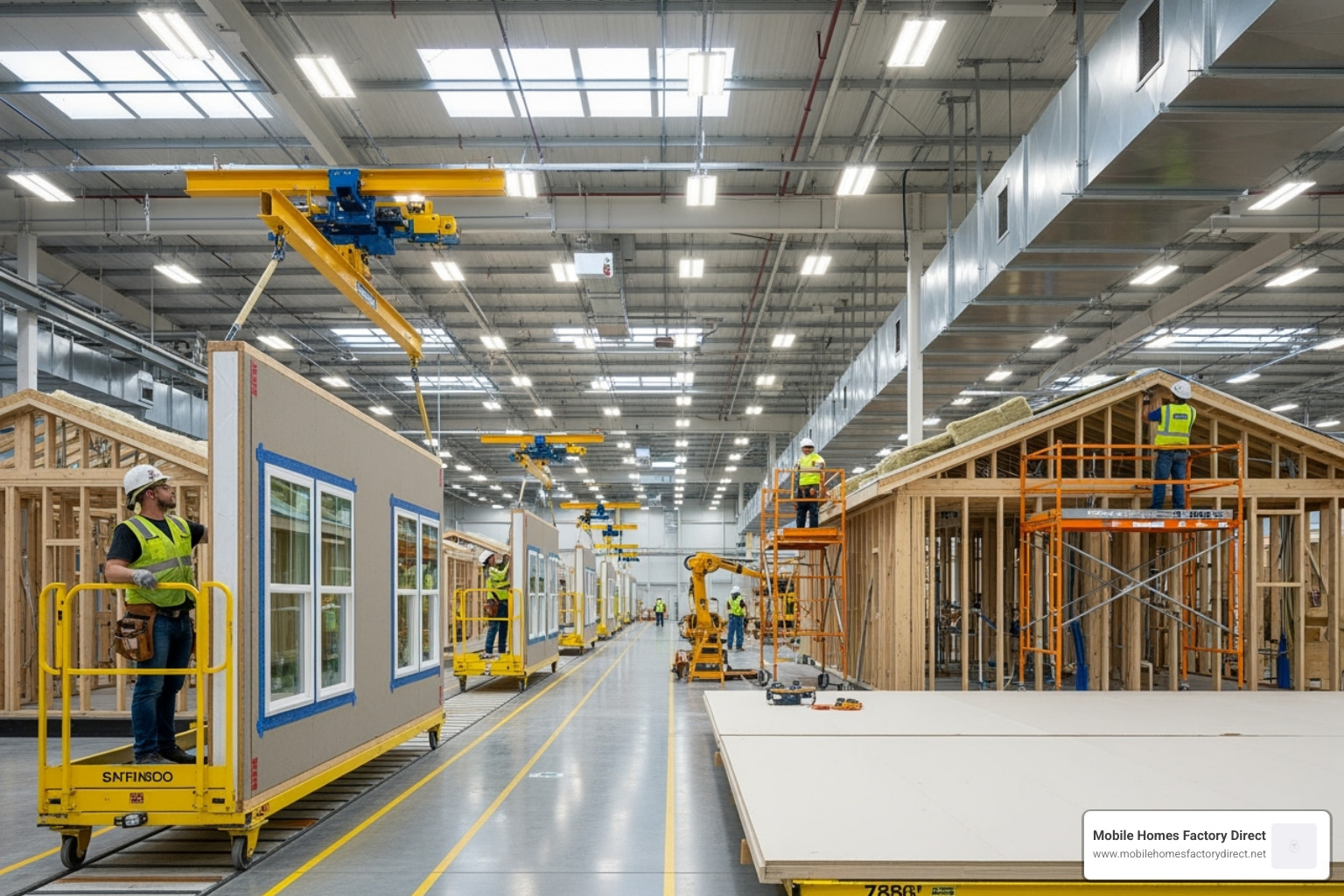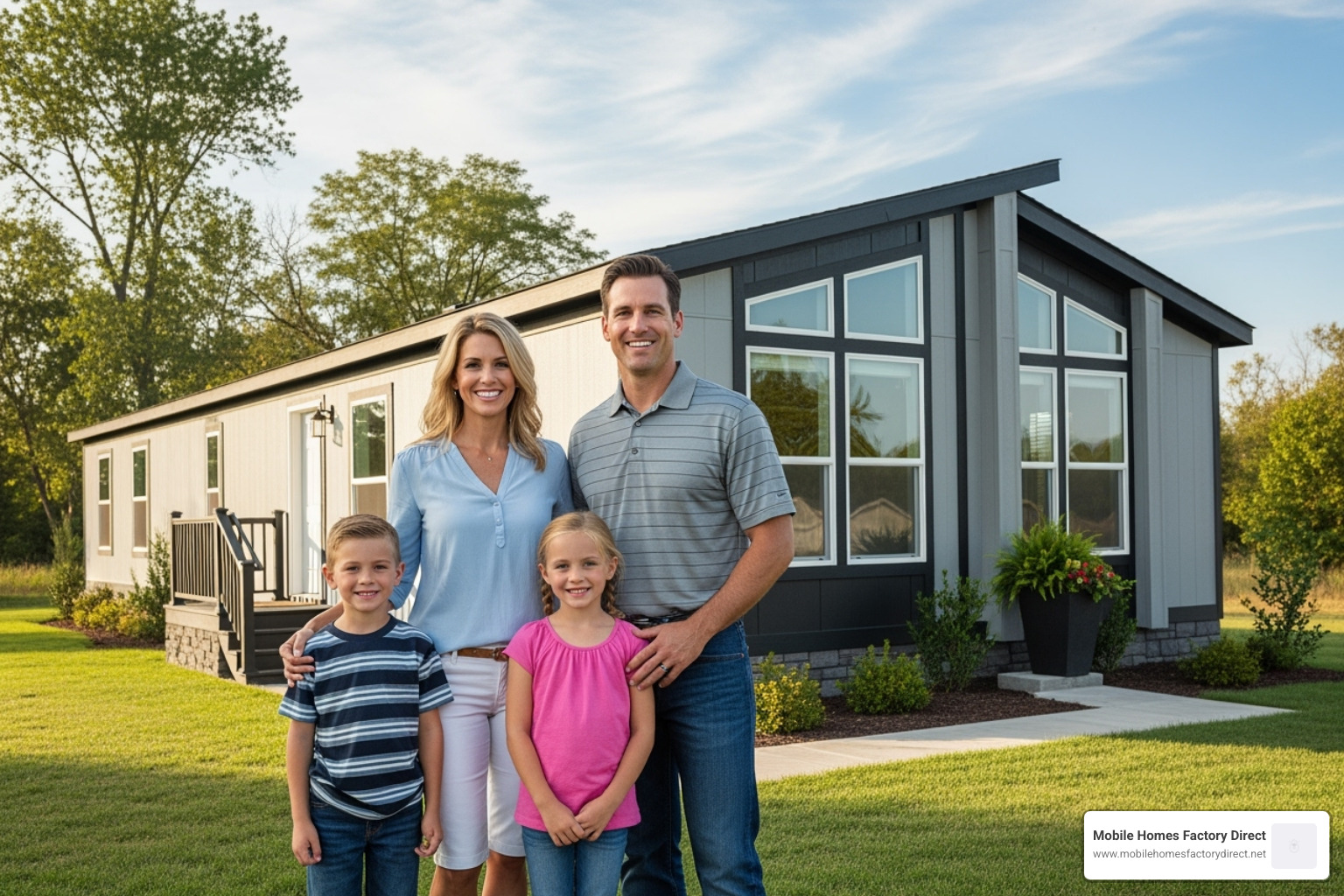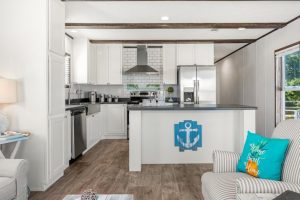The Manufactured Housing Manual: Everything You Need to Know
Understand what is manufactured housing with our complete guide. Explore benefits, financing, quality, and dispel myths today!
Understanding What is Manufactured Housing in Today’s Market
What is manufactured housing? For Americans seeking affordable homeownership, it’s an essential question. With traditional site-built homes becoming less attainable, manufactured homes offer a path to owning a home at a fraction of the cost.
In short, manufactured housing is:
- Factory-built homes constructed to federal HUD Code standards.
- Built on a permanent steel chassis for transportation.
- Transported in sections and assembled on-site.
- Required to display a red HUD certification label proving compliance.
- Designed for permanent placement, not mobility after installation.
The term “manufactured home” officially replaced “mobile home” for new builds in 1980, distinguishing modern, high-quality homes from older trailer-style housing. Built in climate-controlled facilities, these homes offer consistent quality control that often exceeds on-site construction standards.
Today, over 22 million Americans live in manufactured homes, the largest source of unsubsidized affordable housing in the U.S. This guide covers everything from construction and financing to placement, showing how modern manufactured homes make ownership achievable.
The Evolution of Factory-Built Homes: From Mobile to Manufactured
To understand what is manufactured housing today, it helps to look at its evolution. The industry began with “trailer homes” in the early 1900s, designed for frequent moving. After World War II, demand for this affordable housing soared, but inconsistent quality and safety became major concerns.
This led Congress to pass the National Manufactured Housing Construction and Safety Standards Act of 1974. This landmark legislation, effective June 15, 1976, created the federal HUD Code. For a neutral overview of the category, see Manufactured housing.
This date is the official dividing line: homes built before it are “mobile homes,” while those built after are “manufactured homes.” The HUD Code is the only federally-regulated national building code for housing, ensuring consistent standards nationwide.
What is a manufactured home today?
Today, a manufactured home is a factory-built residence constructed after June 15, 1976, that meets the strict federal HUD Code. These homes are built on a permanent steel chassis, which is integral to the home’s structure and allows for transport from the factory. They are delivered in sections and assembled on-site, with a red certification label on each section guaranteeing compliance. Despite being transportable, modern manufactured homes are designed for permanent living; fewer than 5% are ever moved after initial installation.
Manufactured vs. Mobile Homes
While often used interchangeably, “manufactured home” and “mobile home” have key legal and structural differences based on the June 15, 1976 date.
-
Mobile Homes (pre-1976): Built to varied or non-existent local codes. Quality varied greatly, and they were often placed on temporary foundations. They typically depreciate in value and are limited to personal property loans.
-
Manufactured Homes (post-1976): Must meet the federal HUD Code, ensuring consistent quality, safety, durability, and energy efficiency. They can be placed on various foundations, including permanent ones, and can qualify for traditional mortgages when affixed to owned land, giving them better appreciation potential.
Both are factory-built with steel chassis, but the HUD Code transformed manufactured homes into a superior product. For more on available styles, see our guide on different types of manufactured homes.
Construction, Standards, and Quality in Modern Manufacturing
One of the most surprising aspects of modern manufactured housing is the construction process. Homes are built entirely indoors in climate-controlled facilities that resemble high-tech assembly plants. This eliminates weather delays and protects materials from the elements.
The process uses a precise assembly line where specialized teams handle each stage, from framing to finishing. Unlike site-built homes, which are inspected only a few times, manufactured homes undergo continuous quality control inspections at every step. This allows a home to be completed in the factory in just a few days, compared to months for a site-built home.
The HUD Code: A Federal Standard for Safety and Durability
Manufactured homes are the only housing type built to a single federal building code. The HUD Code is a comprehensive standard governing every aspect of construction, including:
- Design and Construction: Ensures structural soundness.
- Strength and Durability: Specifies materials and installation methods.
- Fire Resistance: Mandates flame-spread ratings and escape routes.
- Energy Efficiency: Requires proper insulation and efficient appliances, leading to lower utility bills.
- Wind Safety: After Hurricane Andrew, HUD revamped wind resistance requirements. Homes are now built for specific wind zones, with some designed to withstand hurricane-force winds.
For anyone wanting to dig deeper, HUD’s official resources provide detailed information about these protective regulations.
Evolved Quality and Customization
Today’s manufactured homes have shattered old stereotypes. You’ll find modern features like drywall interiors, open floor plans, and vaulted ceilings. Kitchens boast islands and high-end appliances, while bathrooms feature garden tubs and luxury finishes.
The controlled factory environment prevents weather damage and ensures every step is completed under ideal conditions. This often results in superior quality compared to traditional construction.
Customization options are plentiful. You can choose from various floor plans, exterior finishes, interior materials, and appliance packages. For long-term savings, Energy Star certified homes are a popular choice, offering advanced insulation and efficient systems that significantly cut utility bills.
At Mobile Homes Factory Direct, we’re excited to show you how far manufactured housing has come. See the quality for yourself in our new home models.
The Financial Benefits and Considerations of Manufactured Housing
One of the most compelling reasons to consider manufactured housing is its affordability. As the largest form of unsubsidized affordable housing in the U.S., it provides a realistic path to homeownership. The numbers are clear: a new manufactured home costs less than one-third the price of a comparable site-built home.
The average cost of a manufactured home is around $124,300, compared to $409,872 for a site-built home. Per square foot, the value is even more apparent: manufactured homes average $87 per square foot, while site-built homes are about $166 per square foot. This affordability allows families to build equity and secure their financial future without overwhelming debt.
Key Advantages of Manufactured Homes
Beyond the price, manufactured homes offer several smart benefits:
- Lower Cost: The most significant advantage, making homeownership accessible.
- Faster Build Time: Homes are completed in the factory in days or weeks, not months.
- Controlled Quality: Indoor construction by skilled teams ensures consistency and high standards.
- Energy Efficiency: Many homes are Energy Star certified, leading to lower monthly utility bills.
- No Weather Delays: Factory construction means your move-in date is reliable.
Potential Disadvantages to Consider
It’s also important to understand the full picture:
- Depreciation Concerns: While older mobile homes often lost value, modern manufactured homes—especially when placed on owned land with a permanent foundation—can appreciate.
- Financing Differences: Loans can differ from traditional mortgages. If you don’t own the land, you’ll likely use a chattel (personal property) loan, which may have higher rates. Traditional mortgages are available for homes on owned land.
- Land Costs: You’ll need to buy or lease land, which is an additional cost to budget for.
- Community Fees: If you choose a manufactured housing community, you’ll pay monthly lot rent.
- Zoning Restrictions: Some areas have outdated regulations, so it’s important to research local zoning laws upfront.
At Mobile Homes Factory Direct, we help you steer these considerations with flexible financing for all credit types, including bad or no credit. Our simple process removes the guesswork from finding the right home and loan.
The Path to Ownership: Financing and Placement Options
Ready to make your manufactured housing dream a reality? The journey starts with choosing your home and customizing it to fit your lifestyle. Once you’ve selected your floor plan and finishes, the next step is deciding where it will go.
Placing on private land is a popular option that offers the best potential for building equity. Key considerations include checking local zoning laws and any deed restrictions, ensuring proper site preparation (leveling, grading, drainage), and arranging for utility connections (water, sewer, electricity).
Manufactured housing communities offer a different, maintenance-free lifestyle. These planned neighborhoods are designed for manufactured homes and typically handle site prep and utility hookups. You own your home and lease the land, often gaining access to community amenities.
Understanding Your Financing Options
Financing a manufactured home can be straightforward, and we specialize in flexible financing for all credit types, including bad or no credit.
- Chattel Loans: The most common option, especially for homes on leased land. The home is treated as personal property, similar to a car loan. Terms are often shorter than mortgages, but they are easier to qualify for.
- Traditional Mortgages: If you’re buying the home and land together and placing it on a permanent foundation, you can often qualify for a traditional mortgage. This typically offers lower interest rates and longer repayment terms.
- Government-Backed Loans: FHA loans are a great option, often requiring lower down payments and having flexible credit requirements. For veterans, VA loans can provide excellent financing, sometimes with no down payment.
The financing landscape can seem complex, but we’re here to guide you. We work with lenders who understand manufactured housing and all credit situations. For more details, see our Manufactured Home Financing guide and our complete loan guide.
What is a manufactured housing community?
Modern manufactured housing communities have shed the old “trailer park” stereotype. They are thoughtfully planned neighborhoods offering a unique blend of homeownership and carefree living. Most are land-lease communities, where you own your home but lease the lot, which often includes maintenance and access to amenities like pools, fitness centers, and clubhouses.
Some are resident-owned communities (ROCs), where residents collectively own and manage the property. Others cater to specific lifestyles, such as retirement communities for active adults or even luxury communities with resort-style features. The sense of neighborhood and security is a major draw for the millions of Americans who choose community living.
Frequently Asked Questions about What is Manufactured Housing
We know you might still have questions about what is manufactured housing. Here are straight answers to some of the most common ones we hear.
Do manufactured homes appreciate in value?
Yes, they can, but it depends on several key factors. Unlike older mobile homes that often depreciated, modern manufactured homes can be a smart financial investment.
- Land Ownership: Owning the land your home sits on is the single biggest factor. The land itself can appreciate, boosting your overall property value.
- Permanent Foundation: Installing your home on a permanent foundation (like a concrete slab or basement) helps it get treated more like a traditional home by appraisers and lenders.
- Maintenance and Location: A well-maintained home in a desirable location will always hold its value better.
While appreciation might not be as rapid as some site-built homes, the much lower initial cost means you start with significant savings.
Are manufactured homes safe in storms?
Absolutely. Modern manufactured homes are built to strict federal safety standards for storm resistance. After Hurricane Andrew in 1992, the HUD Code’s wind standards were significantly improved. Today’s homes are built for specific wind zones, with many designed to withstand hurricane-force winds up to 160 mph.
The key to this safety is proper installation and anchoring. Every home must be securely tied down to its foundation according to the manufacturer’s specifications and local codes. This system is what keeps the home stable and safe in high winds.
Can I get a loan for a manufactured home with bad credit?
Yes! We believe everyone deserves a chance at homeownership, regardless of their credit history. We’ve helped countless families with challenging credit find a path to owning a new home.
While a lower credit score may result in a higher interest rate, homeownership is still well within reach. There are lenders who specialize in manufactured home financing and look beyond just the credit score. A down payment, even a small one, can significantly help your chances of approval and may secure a better rate.
Government programs like FHA and VA loans are also more forgiving of credit issues. At Mobile Homes Factory Direct, we work with a network of lenders to find a solution for you. Don’t assume you can’t qualify. Let us help you explore your options. Learn more in our Manufactured Home Loan Complete Guide.
Conclusion
We hope this guide has answered the question what is manufactured housing and revealed how these homes have transformed. Today’s factory-built homes are modern, high-quality, and affordable solutions helping millions of Americans achieve the dream of homeownership.
Built to stringent federal HUD Code standards, modern manufactured homes offer energy efficiency, custom designs, and quality control that often surpasses site-built construction. They have shattered old stereotypes while remaining the most affordable form of unsubsidized housing in the nation.
At less than one-third the cost of site-built homes, manufactured housing provides a realistic path to ownership for first-time buyers, downsizers, and anyone seeking a smart financial choice. It’s a vital part of America’s housing solution.
At Mobile Homes Factory Direct, we are proud to be part of this housing revolution. We believe everyone deserves a quality home. That’s why we offer the best homes at the best prices with a simple process and flexible financing for all credit types, including bad or no credit.
Ready to see what modern manufactured housing can offer you? Explore the different types of mobile homes we offer and let us help you find your perfect new home.

